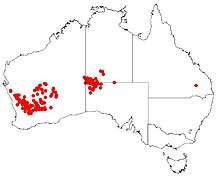Hakea minyma
Hakea minyma, commonly known as watjula,[2][3] is a species of shrub that is endemic to Australia. It has long, flat leaves, fragrant pink or white flower from late winter to spring.
| Watjula | |
|---|---|
 | |
| Hakea minyma in Maranoa Gardens | |
| Scientific classification | |
| Kingdom: | Plantae |
| Clade: | Tracheophytes |
| Clade: | Angiosperms |
| Clade: | Eudicots |
| Order: | Proteales |
| Family: | Proteaceae |
| Genus: | Hakea |
| Species: | H. minyma |
| Binomial name | |
| Hakea minyma Maconochie[1] | |
 | |
| Occurrence data from AVH | |
| Synonyms | |
|
Hakea glabella R.Br. | |
Description
Hakea minyma is a multi-stemmed rounded shrub to 3 m (10 ft) tall with smooth grey bark. The leaves are more than 16 cm (6 in) long and are flat with longitudinal veins ending in a blunt point. Attractive sweetly scented pink or white flowers appear in the leaf axils from August to October. The fruit are smooth, egg shaped, with an upturned beak, turning from brown to grey with age. It has a rounded habit, usually growing to between 1.2–3 m (3 ft 11 in–9 ft 10 in) with long, narrow leaves. Cream or pink flowers are produced in axillary racemose inflorescences between August and November in its native range.[4][5]
Taxonomy and naming
The species was first formally described by botanist J.R. Maconchie in 1973 and the description was published in Transactions of the Royal Society of South Australia.[6][7] The specific epithet minmya is from the Pitjantjatjara word for woman, alludes to the shape of the fruits.[3]
Distribution and habitat
It occurs in Western Australia, the Northern Territory and South Australia.[6] In Western Australia it grows in semi-arid areas south through Mullewa to Merredin and Coolgardie. It is found in north western South Australia in the Central Ranges and the Great Victoria Desert[3] and the in the south western parts of the Northern Territory extending north east to the MacDonnell Ranges.[8] Hakea minyma grows on sandy loam in mallee and mulga woodlands[4] also on spinifex dominated sandplains and dune swales and less commonly on rocky or gravelly ranges.[8]
Conservation status
Hakea minyma is classified as "not threatened" by the Western Australian Government.[5]
References
- "Hakea minyma". Australian Plant Census. Retrieved 17 February 2020.
- "Genus: Hakea". Seeds of South Australia. Government of South Australia. Retrieved 1 October 2018.
- "Hakea minyma". Fact Sheet. Government of South Australia. Retrieved 13 September 2018.
- Young, J A. Hakeas of Western Australia : a field and identification guide. [Perth]. ISBN 0-9585778-2-X.
- "Hakea minyma". FloraBase. Western Australian Government Department of Parks and Wildlife.
- "Hakea minyma". Australian Plant Name Index (APNI), IBIS database. Centre for Plant Biodiversity Research, Australian Government, Canberra. Retrieved 2010-02-26.
- "Transactions of the Royal Society of South Australia". Biodiversity Heritage Library. Retrieved 17 February 2020.
- "Hakea minyma Maconochie". NT Flora. Northern Territory Government. Retrieved 11 October 2018.